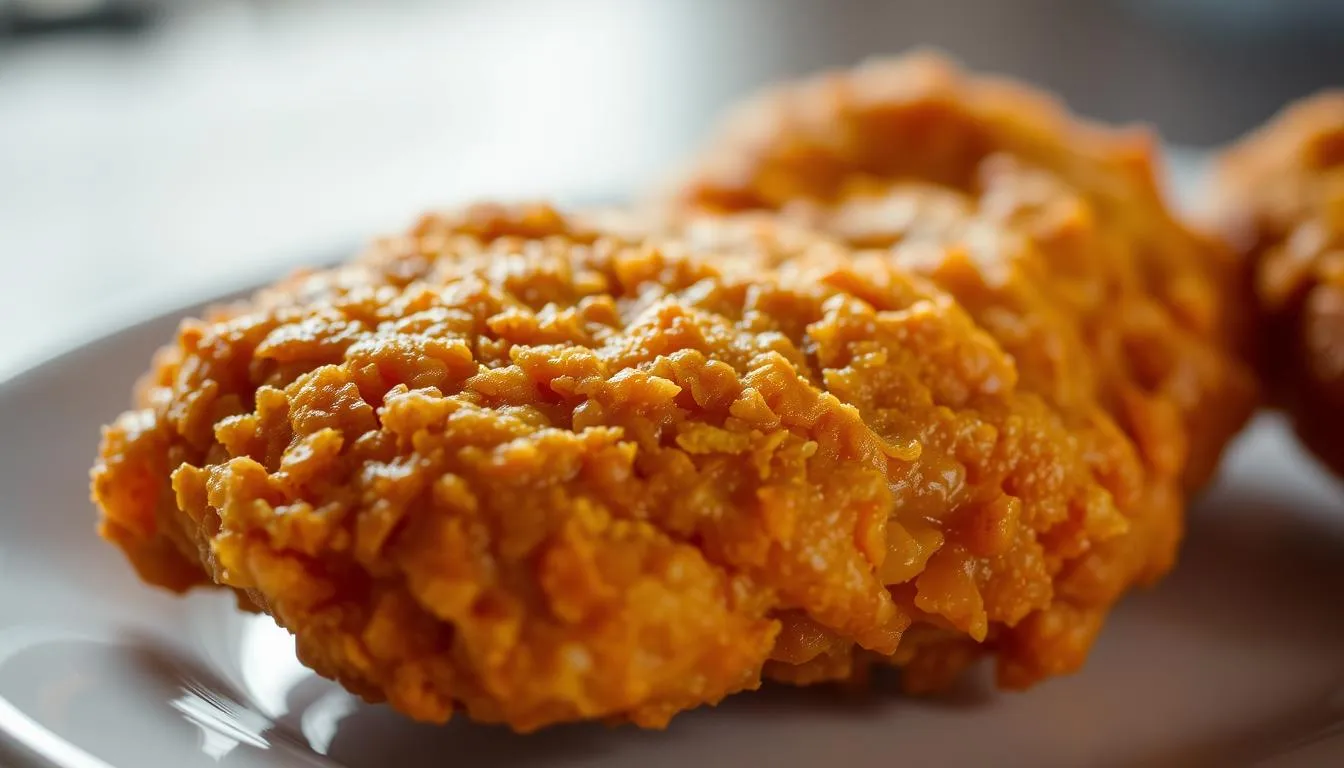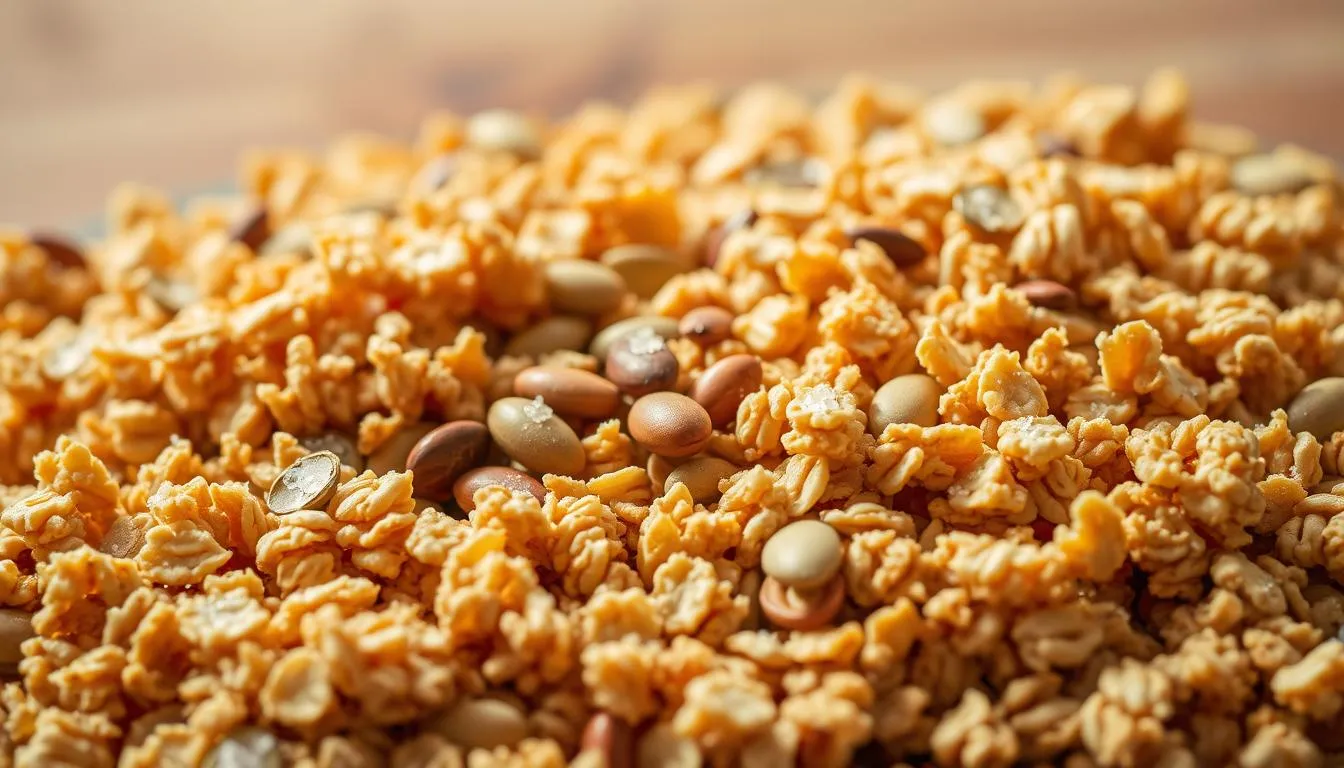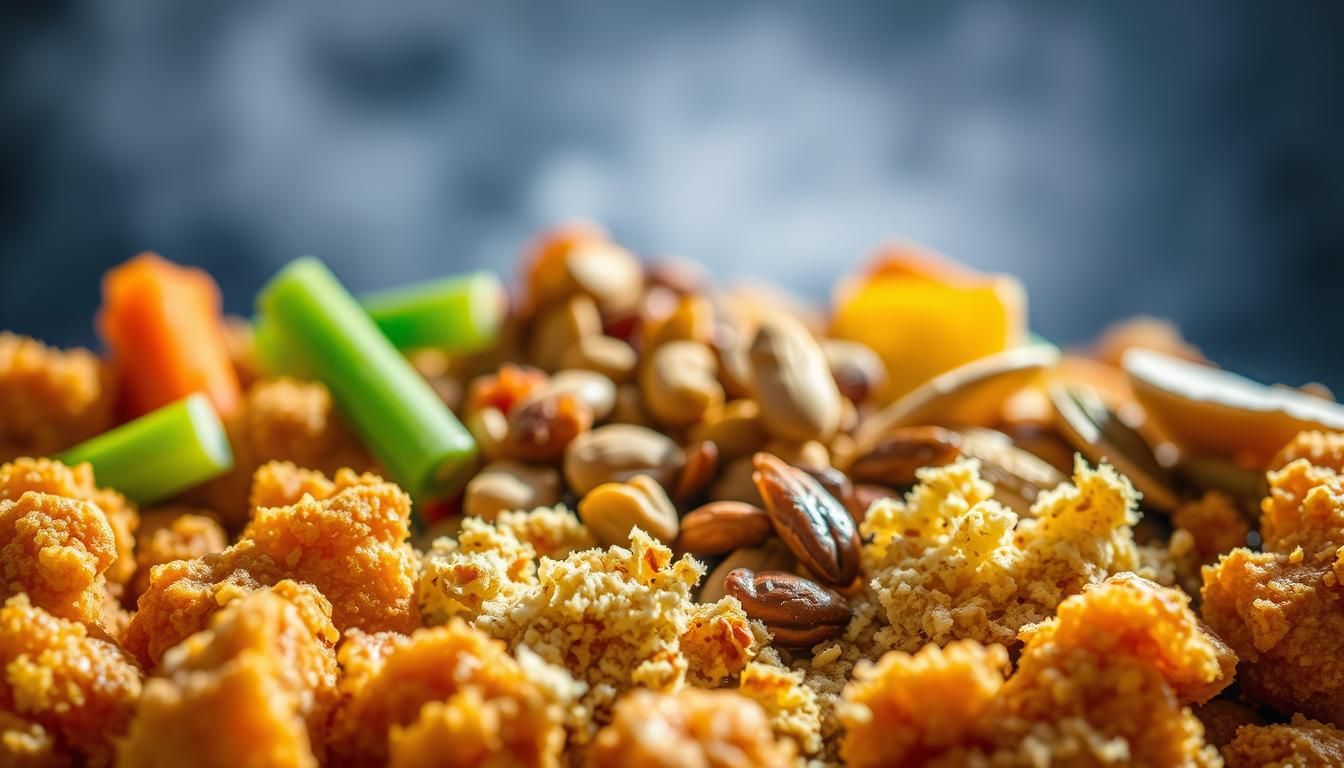I still remember the first time a simple snap changed dinner. A fork lifted a salad sprinkled with toasted buckwheat, and the sound made everyone pause. That small crack made the meal feel complete and very alive.
Sound, crispness, and contrast create what food lovers call the crunch factor. It blends texture and sound to lift flavor and the overall eating experience. Chefs know this helps signal freshness and adds variety without deep-frying.
This short guide previews easy ways to add crisp bites using whole grains, nuts, and quick toppings. You’ll learn pantry habits to keep toppings snappy and simple steps for salads, greens, proteins, and fruit desserts.
For practical techniques and more ideas on making things crispy, check this helpful how-to guide that inspired some of these tips: how to make anything crunchy.
Key Takeaways
- Crunch signals freshness and boosts satisfaction without heavy frying.
- Add crispness with whole grains like toasted buckwheat or popped quinoa.
- Balance textures—aim for lively contrast, not just hardness.
- Keep a mix of toppings on hand to make crunchy options quick and easy.
- Hear the snap: sound enhances the eating experience and flavor perception.
Mastering the Crunch factor in dishes: why sound, texture, and contrast matter
That audible snap at the table tells the brain a lot before the tongue gets to work. The “crunch effect” is simple: crisp sounds and lively textures raise perceived freshness and boost flavor without adding fat.

The science of craveable crunch: the “crunch effect” and sensory satisfaction
The crunch effect links sound to quality. Your brain hears a crisp note and expects a fresh bite. That expectation increases enjoyment and can make a light salad feel more filling.
“Sound is a swift cue that primes taste and memory.”
Sound as the “forgotten food sense” and how it shapes the eating experience
Sound often acts as the forgotten food sense. The audible snap cues quality and primes the eating experience. A small crunchy garnish can change views of a whole plate.
- Texture contrast: pair crisp bits with soft or juicy elements for dynamic bites.
- Benefits: adds variety and perceived flavor without extra salt or sugar.
- Ways to get crunch: toasting, popping, dredging, or tossing whole grains and nuts.
Quick mental check: aim for crisp vs. soft, salty vs. sweet, and warm vs. cool. A tiny sprinkle goes far.
For more on how texture shapes our love of certain bites, see this short piece on texture and enjoyment.
How to add crunch with whole grains and smart techniques
Whole grains are one of the easiest ways to add a lively crunch to everyday meals. Toasting, popping, and simple dredges give texture without heavy frying.

Toast buckwheat as a crouton swap
Toast raw buckwheat in a dry skillet over medium heat until golden and fragrant. Cool, then sprinkle over salads as a crunchy topping that adds warm nuttiness and extra flavor.
Dredge for a longer-lasting crust
Pat proteins or veg dry, season, then coat with whole grain cornmeal, teff, or amaranth. This dredge keeps a crisp coat longer than flour and lifts any dish.
Pop grains to fold into batters
Preheat a Dutch oven, add 2–4 tablespoons quinoa or amaranth, and shake until popped (about one minute). Fold popped grain into brownie, muffin, or banana bread batters to make crunchy textures.
Breadcrumbs, greens, and quick crisps
Pulse stale whole wheat bread to coarse crumbs, toast in olive oil, then stir into sautéed greens with shaved cheese for body and snap.
Fast fruit topping
Scatter granola over sliced fruit and bake until bubbly, or use granola on grilled peaches with frozen yogurt for an easy topping option.
| Technique | Grain | Best Use | Tip |
|---|---|---|---|
| Toasting | Buckwheat | Salad crumble | Toast small batches to avoid bitterness |
| Dredge | Cornmeal/Teff | Chicken, fish, veg | Add smoked paprika or lemon zest |
| Popping | Quinoa/Amaranth | Brownies, muffins | Fold into half the batter for contrast |
Practical note: keep a jar of toasted buckwheat and a bag of whole wheat breadcrumbs ready. This single option can make weeknight meals feel special and help you 2025 views for recipe pages. Also, you can use cookies crumbs sparingly as a topping for desserts or fold cookies into granola mixes for playful texture.
Salads that snap: nuts, seeds, and crunchy toppings that elevate greens
A bright handful of toasted nuts or seeds can turn a plain salad into something memorable.
Pecans bring antioxidants, zinc, and magnesium, while hazelnuts add vitamin E and copper. A small scoop adds warm, toasty flavor and a satisfying bite.

Nuts and seeds to add crunch: pecans, hazelnuts, chia, and flax
Chia and flax give omega-3s, fiber, and a gentle pop that works well with softer leaves. They blend without overpowering taste.
Indulgent lift: crispy fried onions and shallots for sweet-savory bite
Fried onions offer caramelized sweetness; fried shallots deliver a delicate, ultra-crispy snap. Use them sparingly with tangy dressings or creamy ranch.
Pairing guide: match toppings with greens and dressings for texture contrast
- Peppery arugula or kale → richer nuts like pecans or hazelnuts.
- Spinach or lettuce → light seeds such as chia or flax and bright vinaigrette.
- Fried shallots → pair with tangy vinaigrettes to cut richness.
- Start with ~2 tablespoons of crunchy toppings per salad and adjust to taste.
| Topping | Nutrition | Best with | Use beyond salad |
|---|---|---|---|
| Pecans | Antioxidants, zinc, magnesium | Arugula, kale | Grain bowls, wraps |
| Hazelnuts | Vitamin E, copper | Mixed greens, bitter lettuces | Breakfast bowls, tarts |
| Chia & Flax | Omega-3s, fiber | Spinach, lettuce | Smoothies, yogurt |
| Fried onions/shallots | Sweet-savory crunch | Tangy vinaigrettes, creamy dressings | Wraps, grain salads |
Prep tip: toast nuts in a dry pan until fragrant, cool fully, then chop. Store crunchy toppings airtight and add them just before serving to preserve texture and boost the salad experience.
Sweet finishes and snacks: crunchy textures in desserts and fruit-forward recipes
When apricots meet buttery nuts, you get lively contrast that lifts both flavor and texture. This pairing works across breakfasts, snacks, and desserts. Toasted macadamias add a firm, buttery bite that complements soft fruit.
Apricot meets macadamia: buttery-crisp combos from bowls to tarts
Top warm oatmeal with toasted macadamias and chopped dried apricots for a quick, bright breakfast. Or stir macadamia butter into a smoothie bowl, then finish with a sprinkle of chopped nuts for instant crunchy toppings.
Maintain crunch: toast and timing
- Toast nuts until fragrant and lightly browned, then cool fully before chopping.
- Add crunchy toppings just before serving to preserve texture and flavor.
- To salvage softened bits, re-toast briefly in a low oven to make crunchy pieces bounce back.
Store crunchy elements right
Keep toasted nuts and other crunchy toppings in an airtight container. For longer life, refrigerate or freeze to store crunchy snacks without loss of texture.
| Use | Tip | Best with |
|---|---|---|
| Breakfast bars | Press oats, apricots, macadamias; chill | Oatmeal, smoothies |
| Apricot crisp | Oat-macadamia topping, bake until golden | Warm fruit desserts |
| Tart upgrade | Fold chopped macadamias into frangipane | Pastry and dessert crusts |
Note: a pinch of salt on nut toppings will boost flavor without hiding the fruit. Try these simple recipes and share your results — they often drive extra 2025 views and comments.
Conclusion
A simple crisp topping can lift any meal from ordinary to memorable.
Quick wins: keep toasted grain jars and chopped nuts ready. Add crunchy toppings just before plating to preserve snap and boost flavor.
Use a short checklist: one crisp element, a soft base, and a bright note of acid or salt to highlight texture contrast and improve the eating experience.
Rotate grains like buckwheat, amaranth, quinoa, and cornmeal with pecans, hazelnuts, or macadamias. Try popped grain accents on brownies and loaves for light crunchy textures.
Store toppings airtight and listen for that subtle crunch—it signals your timing worked and invites repeat comments and happy plates.
FAQ
What is the “crunch effect” and why does it matter?
The “crunch effect” describes how crisp textures and audible sound increase enjoyment and satisfaction when eating. Sound, mouthfeel, and contrast with softer components make bites more interesting, boost perceived freshness, and can improve overall flavor perception.
How can I add crunchy texture to salads without making them soggy?
Use toasted nuts, seeds, or quick-roasted whole grains and add them just before serving. Choose sturdy toppings like pecans, hazelnuts, toasted buckwheat, or granola. Keep dressings light and serve toppings separately if the salad will sit for a while.
Which whole grains work best as crunchy toppings or coatings?
Cornmeal, teff, amaranth, and popped quinoa are excellent choices. Cornmeal and teff make crisp coatings for chicken, fish, or vegetables. Popped quinoa and amaranth add delicate crunch to batters, desserts, and grain bowls.
What’s the easiest way to get a crispy coating on proteins?
Dredge proteins in seasoned cornmeal, crushed whole-grain breadcrumbs, or a mix of teff and panko, then pan-fry or bake until golden. The combination of dry coating plus hot oil or oven heat creates a satisfying crisp exterior.
How do I keep nuts and granola crunchy for longer?
Cool toppings completely after toasting and store them in an airtight container at room temperature. For best texture, add granola or chopped toasted nuts right before serving. Avoid storing with moist ingredients like sliced fruit.
Can I use whole-wheat breadcrumbs to add texture to vegetables?
Yes. Stir toasted whole-wheat breadcrumbs into sautéed greens or roasted vegetables for body and bite. They add a toasty note and help absorb excess oil without becoming mushy.
What crunchy toppings pair well with specific greens and dressings?
For peppery arugula, use toasted hazelnuts and a lemony vinaigrette. Butter lettuce pairs with toasted pecans and a creamy herb dressing. Bitter radicchio benefits from crispy fried shallots and an oil-forward, slightly sweet dressing for contrast.
Are there quick ways to add crunch to desserts and fruit bowls?
Yes. Top warm fruit with granola or chopped toasted macadamia nuts, fold popped amaranth into batters, or sprinkle chopped toasted almonds over yogurt. Add toppings at the last minute to preserve texture.
How do I toast nuts properly without burning them?
Use a dry skillet over medium heat and shake frequently, or toast in a 325°F oven for 8–12 minutes, checking often. Remove them as soon as they’re fragrant and lightly browned, then cool on a tray to stop cooking.
What’s the best way to add crunch to weeknight meals with minimal prep?
Keep a jar of toasted seeds, granola, or popped grains on hand. Sprinkle over salads, soups, or roasted vegetables just before serving. Pre-toast a batch of nuts on the weekend and store them sealed for grab-and-go texture boosts.
